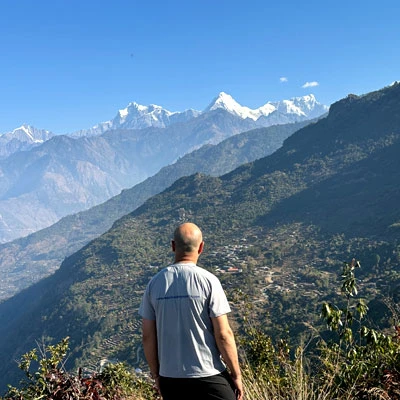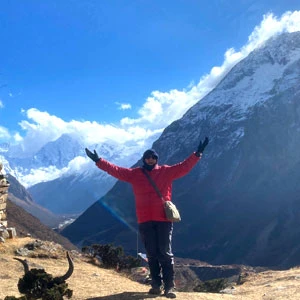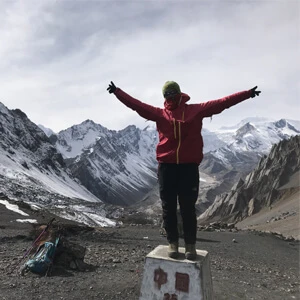Quick Overview of The Manaslu Circuit Trek
Trekking Region: Manaslu
Trekking Duration: 17 Days
Difficulty Level: Moderately Challenging
Maximum Altitude: 5,106 meters / 16,752 feet at Larkya La Pass
Best Time: Spring (March to May) and Autumn (September to November)
The Manaslu Circuit Trek is one of Nepal’s most spectacular high-altitude adventures, circling the majestic Mount Manaslu (8,163 meters), the eighth-highest peak in the world. Stretching across approximately 177 kilometers (110 miles), this remote and challenging route winds through diverse terrain, from subtropical forests and terraced fields to glacial valleys and alpine ridges, culminating at the awe-inspiring Larkya La Pass (5,160 meters). Unlike the busier Everest or Annapurna circuits, the Manaslu trail offers a more immersive, off-the-beaten-path trekking experience which ideal if you are seeking solitude, authenticity, and raw Himalayan wilderness.
Additionally, what truly sets the Manaslu trek apart is its deep cultural heritage and preserved natural environment. As a restricted area trek, the region remains relatively untouched, hence, you will get to witness the raw and traditional lifestyles of Gurung and Tibetan-influenced communities in villages like Sama Gaun, Lho, and Samdo. Along the route, you will explore ancient monasteries, cross dramatic suspension bridges, and trek beneath towering snow peaks within the Manaslu Conservation Area Project (MCAP).
Major Highlights
Cross one of the highest and most dramatic mountain passes, Larkya La Pass.
Experience Tibetan-influenced villages, monasteries, and traditional prayer wheels.
Visit historic Buddhist monasteries such as Pungyen Gompa and Sama Gompa.
Pass through lush subtropical forests, alpine meadows, rocky moraines, and high-altitude deserts.
Manaslu Trekking Difficulty Level - Can Beginners Handle It?
The Manaslu Circuit Trek is moderately challenging, but with proper preparation, even determined beginners can conquer its rugged trails, high-altitude passes, and remote terrain.
Altitude & Acclimatization Challenges
One of the biggest challenges of the Manaslu Circuit Trek is adjusting to the increasing altitude, especially as you ascend toward the Larkya La Pass at 5,160 meters, the highest point of the trek. For beginners, this high-altitude environment poses a real risk of Acute Mountain Sickness (AMS), which can occur above 2,500 meters if you ascend too quickly without proper acclimatization.
Hence, you may face symptoms like headaches, nausea, dizziness, and fatigue that will slow you down or even force evacuation if not taken seriously. To minimize altitude-related issues, it’s crucial to follow a gradual ascent profile, include acclimatization days (especially in Sama Gaun or Samdo), and stay well-hydrated throughout the journey. You must follow the golden rule of "climb high, sleep low" and learn to recognize early symptoms of AMS.
Trail Terrain & Elevation Gain
The trail terrain of the Manaslu Circuit Trek is varied and ever-changing, taking you through lush lowland forests, rocky river valleys, steep stone staircases, and narrow alpine paths carved into hillsides. As you progress from lower elevations near Machha Khola to the snow-covered heights of Larkya La Pass, the trail becomes more rugged, with sections prone to landslides and rockfalls, which can be especially tough for beginners. You will also cross numerous suspension bridges and climb sharp switchbacks, all while adapting to the thinning air.
Over the course of the 177 km Manaslu Circuit trail, you will experience a gradual elevation gain from 960 meters to over 5,100 meters. However, the route here is designed with a natural acclimatization pattern, ascending slowly through Namrung, Lho, and Sama Gaun, before reaching the demanding climb over Larkya La. Each day involves 500 to 900 meters of ascent, which requires 6 to 8 hours of trekking. While the trek is physically demanding as beginner, proper pacing, conditioning, and taking strategic rest days can help you manage the altitude gain and technical terrain.
Trek Duration
The Manaslu Circuit Trek typically takes between 14 to 18 days to complete, depending on your chosen route, side trips, and pace of acclimatization. Most itineraries begin at Machha Khola and end in Dharapani, covering roughly 177 kilometers (110 miles) of trail. For beginners, a 17-day Manaslu Circuit Trek itinerary with built-in acclimatization days in Sama Gaun and Samdo is ideal to adapt to the altitude and avoid fatigue. This flexible duration allows you to move at a steady, manageable pace while enjoying the scenic beauty and cultural richness along the way.
However, for beginners, maintaining a steady pace over such long periods can be exhausting, especially as the altitude increases and the oxygen levels drop. Hence, the repetitive strain on muscles, combined with unpredictable weather and changing trail conditions, can quickly drain energy and motivation.
Weather & Environmental Hazards
The weather along the Manaslu Circuit Trek can shift dramatically with elevation and season, making it essential for beginners to prepare for a wide range of conditions. In the lower sections, you will find warm, humid days, while the higher altitudes near Larkya La Pass (5,160 meters) can bring freezing temperatures, strong winds, and sudden snowfall, even during these peak trekking months.
On a similar note, beginners often seem to underestimate how cold it can get at night, especially in villages like Samdo and Dharamsala. Hence, without proper layering and gear, staying warm becomes difficult, which can lead to exhaustion or even hypothermia.
Beyond unpredictable weather, environmental hazards like altitude sickness, avalanches, rockfalls, and hypothermia in the higher regions pose real risks. Crossing Larkya La requires an early morning start to avoid harsh afternoon winds and ice buildup, which can make the pass treacherous. Therefore, as a beginner, you should stay updated on local forecasts, use proper trekking gear, and always consult with guides before making critical decisions.
Assessing Manaslu Circuit Trek For Beginners - Is It Possible?
The Manaslu Circuit Trek is undeniably difficult and strenuous, but it’s not impossible for beginners. While the high altitude, steep ascents, and long trekking days make it one of the more challenging treks in Nepal, first-time trekkers with the right preparation and mindset can still succeed.
To take on this trek as a beginner, you need to be reasonably fit and prepared to push through physical and mental challenges. Additionally, having some prior trekking experience is a plus, but it’s not a strict requirement. If you have never trekked before, it is smart to start with shorter treks like the Poon Hill Trek or the Langtang Valley Trek to get a feel for the altitude and trail conditions.
When Is The Best Time To Trek To Manaslu Circuit For Beginners?
Choosing the best time for the Manaslu Circuit Trek is the single biggest factor that determines whether you will succeed or struggle during this trek as a beginner. For most first-timers, the sweet spot falls in Autumn (late September to mid‑November) when crystal‑clear skies, mild daytime temperatures, and low precipitation create ideal trail conditions. October, in particular, is famous for postcard‑perfect panoramas of Mount Manaslu.
Similarly, Spring (March to early May) is a close runner‑up as you will find slightly warmer afternoons and the possibility of afternoon clouds. During these months, you will also get spectacular rhododendron blooms and longer daylight hours which is perfect for a relaxed, beginner‑paced itinerary.
However, you must avoid the Monsoon (June to early September) if you are new to high‑altitude trekking. During this season, you will find heavy rain that triggers leeches, landslides, and washed‑out bridges on the lower trail, while lingering cloud cover hides the mountains you came to see. Moving on, Winter (mid‑December to February) brings deep snow and sub‑zero wind‑chill on Larkya La Pass, making it a serious undertaking even for seasoned mountaineers.
Altogether, if your schedule is fixed, you can also decide trekking on a narrow shoulder window (early December or late February) but only with proper gear, a flexible plan, and an experienced guide who knows local weather patterns.
Permits & Regulations (MCAP, ACAP, RAP)
Trekking the Manaslu Circuit requires three official permits due to its classification as a restricted area trek in Nepal. To enter and hike the region legally, you will need the Restricted Area Permit (RAP) for Manaslu, along with entry permits for both the Manaslu Conservation Area Project (MCAP) and the Annapurna Conservation Area Project (ACAP). Importantly, you must trek with a registered guide and be in a group of at least two people to obtain the Manaslu RAP, which helps ensure safety and responsible travel in this remote zone.
As of 2025, the Manaslu Restricted Area Permit costs USD 100 per person for the first 7 days, and 15 for each additional day during the Autumn (peak) season. In the off-season (December to August), the price drops to USD 75 for the first 7 days and 10 for each additional day. Likewise, both the MCAP and ACAP permits cost USD 30 each and remain valid for the entire trek duration. These permits can all be arranged through your trekking agency
As a beginner, you should plan ahead to meet these permit requirements and avoid delays. If you are thinking about extending your route to include Tsum Valley, an additional Tsum Valley Restricted Area Permit is required, adding both cost and time to your journey.
How To Prepare For Manaslu Circuit Trek As A Beginner?
Physical Conditioning
Solid physical conditioning is the single best predictor of whether a first‑timer thrives or merely survives on the Manaslu Circuit Trek. You should aim to build a foundation of cardiovascular endurance, leg strength, and core stability eight to twelve weeks before you hit the trail. Because you will be walking 6 to 8 hours a day at altitudes above 3,500 meters, you must focus on steady‑state cardio (jogging, cycling, rowing) three to four times weekly, each session lasting 45 to 60 minutes.
Similarly, you must also carry on with strength workouts twice a week that target quads, glutes, calves, and core with weighted step‑ups, walking lunges, deadlifts, and planks. Then, you should replicate trail conditions with weighted stair climbs or local hill hikes: starting with a 5 kg (11 lb) pack and gradually increase to the 10 to 12 kg you will carry on the mountain. This progression mimics real‑world stress on joints and stabilizing muscles, reducing the risk of knee pain and ankle twists on Larkya La’s rocky switchbacks.
Finally, you should try yoga, dynamic stretching, and one full rest day per week to avoid overuse injuries and accelerate adaptation.
Mental Preparation & Endurance
Mental resilience is just as critical as strong legs on the Manaslu Circuit Trek, where long days, thin air, and remote terrain can test even seasoned hikers. You should start your mental preparation for Manaslu Circuit Trek a month or two before departure by simulating discomfort such as hiking in bad weather, finishing workouts even when you are tired, and practicing early‑morning starts. These controlled stressors will teach your brain to stay calm and focused when the real challenges appear.
You can also use visualization techniques, breath steadily, and build everyday mindfulness habits to strengthen mental endurance for high‑altitude trekking. Here, a simple breathing drills (inhale for 4 counts, exhale for 6) reduce heart rate and combat altitude‑induced restlessness.
Altitude And Acclimatization Strategies
A well-planned acclimatization strategy is absolutely essential for anyone trekking the Manaslu Circuit, especially for beginners who are unfamiliar with the effects of high altitude. The trek rises steadily from subtropical lowlands around 900 meters to the towering Larkya La Pass at 5,160 meters, where oxygen levels drop significantly. To avoid Acute Mountain Sickness (AMS), you must follow the “climb high, sleep low” principle and allow the body time to adjust to thinner air.
Additionally, your itinerary must include acclimatization days in key high-altitude villages like Samagaun and Samdo. These rest days provide you the opportunities for active acclimatization through short hikes that help your body adapt.
Likewise, you should also monitor for early signs of AMS such as headache, nausea, dizziness, and loss of appetite. Along the trail, you must be well-hydrated, avoid alcohol and smoking, and walk at a slow, steady pace. Now, if you begin to feel the effects of altitude sickness, you should stop, rest, and communicate with your guide. They will help monitor your symptoms and decide if it’s necessary to descend to a lower elevation.
Hiring Guide And Porter
For beginners, hiring a guide and porter on the Manaslu Circuit Trek is a necessity. As this trek takes you through remote areas with challenging terrain, you will need an experienced local guide to help you through the journey.
A liscensed trekking guide in Nepal will help you navigate the often tricky trails and ensure your safety in areas prone to landslides or unstable paths. They also provide cultural insights, help you communicate with locals, and ensure that your acclimatization schedule is followed to avoid altitude sickness.
On the other hand, a porter helps you carry your heavy gear, allowing you to focus on your trek. This becomes especially important if you are a beginner, as you may not yet have the stamina or strength for long days of trekking while carrying weight.
Having a porter can drastically reduce physical fatigue and make the experience more enjoyable. Together, a guide and porter help create a more manageable, comfortable trek offering peace of mind to beginners who may be unfamiliar with the demanding conditions of high-altitude treks.
Safety, Insurance & Emergency Protocols
When trekking the Manaslu Circuit, safety must be your top priority, especially as a beginner navigating high-altitude terrain, unpredictable weather, and remote locations. The region’s isolation means that emergency help is not immediately available, and sections like the Larkya La Pass can be dangerous due to snow, wind, or altitude sickness. That’s why you must secure comprehensive trekking insurance. Here, your policy must cover high-altitude trekking above 5,000 meters, medical evacuation by helicopter, trip cancellation, and emergency hospitalization.
In addition to insurance, it’s vital to be aware of basic emergency protocols for the Manaslu trek. Always trek with a licensed guide, as they are trained in first aid, know evacuation procedures, and can quickly recognize signs of acute mountain sickness (AMS), hypothermia, or dehydration. If possible, you can also carry a satellite phone or local SIM card (NTC has better coverage than Ncell in this region), and know the locations of key medical points. Lastly, you should prepare for emergencies by packing a basic first-aid kit, extra cash, and copies of your documents and insurance policy.
Essential Tips For Beginners Attempting Manaslu Circuit Trek
- Train for Altitude and Endurance: Start physical training at least 8 to 10 weeks before your trek, focusing on cardio, leg strength, and uphill hiking. It helps you cope with long days and the demanding elevation gain of the Manaslu trek.
- Acclimatize Slowly and Properly: Stick to a gradual ascent profile and take rest days in Samagaun or Samdo to reduce the risk of altitude sickness. Follow the golden rule of “climb high, sleep low.”
- Hire a Licensed Guide and Porter: A registered guide is mandatory for the Restricted Area Permit, and porters help lighten your load. They also provide local insight, safety support, and make the trek more manageable for newcomers.
- Choose the Right Season: Trek during Spring (March to May) or Autumn (September to November) for stable weather and clear views.
- Pack Light And Smart: Bring only essentials such as quality trekking boots, moisture-wicking layers, a sleeping bag rated for -10°C, and a down jacket.
- Stay Hydrated and Eat Well: Drink 3 to 4 liters of water daily and eat high-carb meals to sustain energy. Avoid alcohol and caffeine at higher altitudes as they worsen dehydration and AMS symptoms.
- Buy the Right Insurance Policy: Make sure your travel insurance covers trekking above 5,000 meters, emergency helicopter evacuation, and medical care in Nepal.
- Be Flexible and Patient: Mountain weather and trail conditions can change unexpectedly. So, build a buffer day into your itinerary and maintain a flexible mindset for a safer, less stressful journey.
- Mentally Prepare for the Challenge: Manaslu trek for beginners isn’t easy, but with the right attitude and preparation, it can be one of the most rewarding adventures you will ever complete.
Conclusion
The Manaslu Circuit Trek may be remote and physically demanding, but with the right mindset, preparation, and guidance, it’s an incredibly rewarding journey, even for beginners. While factors like altitude acclimatization, trail difficulty, and permits might seem intimidating at first, by understanding the altitude challenges and proper acclimatization strategies, even novice trekkers can take on this magnificent journey.
If you are ready to step out of your comfort zone and into the heart of Nepal’s untouched beauty, contact Nepal Trekking Experts to plan your Manaslu Circuit Trek for 2025. Let this guide be your starting point to plan, prepare, and take that first bold step into the mountains.
FAQs
Is the Manaslu Circuit Trek suitable for beginners?
Yes, with proper preparation and support, even beginners can complete the Manaslu Circuit Trek.
How difficult is the Manaslu Circuit Trek?
The Manaslu trek in Nepal is challenging due to altitude, long days, and rugged terrain.
How long does the Manaslu Circuit Trek take?
This trek typically takes 12 to 16 days, depending on the itinerary and acclimatization schedule.
What is the maximum altitude on the Manaslu Circuit Trek?
The highest point is Larkya La Pass at 5,160 meters (16,929 feet).
Do I need to hire a guide and porter for the trek?
While not mandatory, NTE recommends you hire a guide and porter, especially for beginners.
When is the best time to do the Manaslu Circuit Trek?
The best seasons for the trek to Manaslu Circuit are Spring (March to May) and Autumn (September to November) when the weather is most favorable.
Can beginners complete the trek solo?
While some may can, but NTE highly recommended trekking with a guide, especially for beginners, as the trail can be challenging to navigate.
Do I need special permits for the Manaslu Circuit Trek?
Yes, the trek requires a Manaslu Conservation Area Permit (MCAP), a Restricted Area Permit (RAP), and a Annapurna Conservation Area Permit (ACAP) which can be arranged through a trekking agency.a







